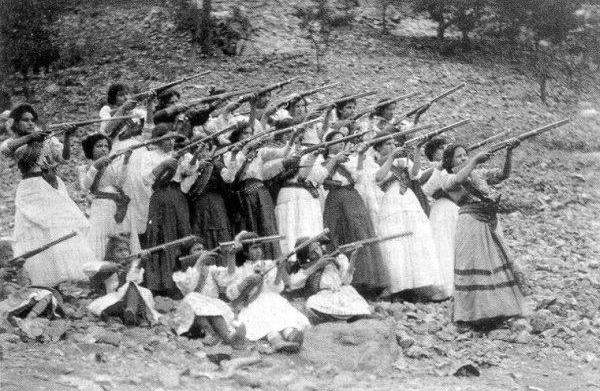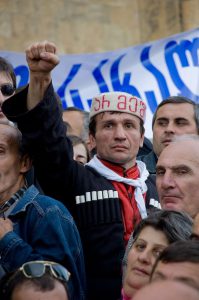Winner of the Spring 2018 StMU History Media Award for
Best Article in the Category of “Gender Studies”
“La Adelita” was one of the most popular corridos, or songs of romance, during the Mexican Revolution (1910-1920).1 This song is the love story of a young woman who travels with a sergeant and his regiment during the revolution.2 The song praises Adelita, the sweetheart of the troop, for both her beauty and her valor, noting how she is wanted by the other soldiers. We can imagine this woman as an object of desire, whose beauty and physique attracted the soldiers, and eventually broke their hearts. But this description is actually… incorrect.3
The Adelita, also known as soldadera, or female soldier, is the term used to describe women who contributed to many aspects of the Mexican Revolution. These women worked as nurses, food providers, lovers, spies, messengers, and fighters.4 In fact, some reached the rank of colonel and general. Many of them were forced by their husbands to follow them and work in the camps, but there were also those who volunteered to join the cause.5 Today, soldaderas are remembered as strong and courageous women who took up weapons and became fighters, often having to cut their hair and dress to appear like their male counterparts, because of the oppressive gender inequality prevalent in the Mexican society of that time.6 There is one soldadera in particular, Petra Herrera, also known as La Guerrera, and as La Generala (female general), who joined the cause and fought with the strongest of the soldiers. But what inspired women to join their male counterparts to fight this war, and why did the revolution even happen?

To answer this question and to be able to understand why these women now make up a very important aspect of Mexico’s history and its formation as a country, we need to go back in time to 1876, when the general and politician Porfirio Díaz became president. Porfirio Díaz was known to be a corrupt, elitist president, who favored wealthy landowners, industrialists, and foreign interests.7 The country was also known for the slave-like conditions rural people faced while working on the haciendas owned by wealthy landowners.8 These rural workers were very dissatisfied with the lack of voice they had in the government. But the precipitating event that sparked the revolution was Díaz’s announcement, in 1908, that he would run for his seventh term as president in 1910. This caused controversy among the people who had been suffering from his long regime. Francisco I. Madero then rose as the leader of the Antireeleccionistas (Anti-Reelection alliance). Madero subsequently announced that he would be running for president against Díaz. This prompted the mobilization of armies throughout Mexico. Countless leaders, such as Pascual Orozco and Pancho Villa, began raiding government garrisons as part of an uprising to remove the current president and eventually, elect a new president for the country.9 These were some of the events that inspired and sparked the courage of not only men but of women as well, to join the armies and fight for the shared goal of overthrowing Díaz’ dictatorship and make democracy in Mexico a reality.10

Petra Herrera witnessed the suffering of her country and decided to take action. She witnessed the harshness of landowners and the terrible conditions in which workers lived. She knew that the government had to change from being a corrupt one to being a democratic and fair one. But how would she help? Women at that time faced strict social prohibitions that kept them from playing important roles in the workforce. Instead, they were expected to be caregivers, stay at home, and take care of their children. Women were seen as precious and delicate, something that could not blend with the harshness of war. Petra, instead of following that norm, disguised herself as a man and started calling herself “Pedro Herrera” in order to join the revolutionary troops of Pancho Villa.11
During her time in the camp, she had to lie to her fellow soldiers in order to protect her identity. For example, she would lie that she shaved at dawn before the other soldiers woke up.12 Because of this, “Pedro” was able to blend in perfectly. Quickly after her joining the army, Petra was recognized as an aggressive fighter who carried out military operations efficiently and strategically. In disguise, she came to be known as a courageous and brave soldier, and was soon praised for her intelligence and her skills at blowing up bridges.

Thanks to the acknowledgment she faced on behalf of her peers and her establishment as a strong soldier, Petra decided she would confess her true identity. She believed this would not affect her position or status in the militia, and that she would be accepted and even promoted to general. But sadly, when she told the truth, she was removed from the army instead.13 Consequently, she decided to organize a group of women who were likewise removed from combat, even after they had fought courageously for the same cause as their male counterparts. Petra decided not to give up, and she organized a group of more than four hundred women with the same motive: to put an end to the current presidency and the hardships that Díaz had imposed on the citizens. Her militia not only fought in several battles, but Petra united these fighting women with Pancho Villas’ forces, despite his denial of them fighting and bearing arms. Together, they were able to take the city of Torreón on May 30, 1914, which had been a military base for Díaz’s central federation.14 At the end of the fight, she requested General Castro, a leader of the revolution, to allow her to re-enter the military and make her general, but he only granted her the title of colonel and disbanded her woman’s brigade.15 But her work did not end there. After the demobilization of the woman’s militia, Petra decided to join Venustiano Carranza, one of the main political leaders of the revolution who later became president of Mexico. She became a spy for him and worked as a bartender in Jimenez, a city in the northern part of Mexico.16 But while she was working there, she was shot three times by a group of drunk men, later dying from the injuries.
Despite the effort and the work Petra Herrera gave for the revolution, she has barely received any acknowledgment as a soldadera. There are several causes for this. Men during those times had mixed feelings about women being in combat and the role they had in the fight.17 One of the most passionate opponents of women joining the militia and bearing arms was Pancho Villa. He viewed women as liabilities to an army’s offensive strategy and combative potential, even though Petra Herrera and other great female combatants fought at his side several times to free the country from the oppressive presidency.18 There was also the idea that soldaderas were just images of romance during the Mexican Revolution, such as the song of “The Adelita,” contributing to recognizing only a few of them as strong fighters and contributions to this era.19 These women should be acknowledged and we should grant them a higher praise because many were forced to take this role of soldaderas after being abducted and often raped by revolutionaries who invaded their towns and cities. At the end of the day, the labor and effort of women such as Petra were very important factors for what we have come to know as the Mexican Revolution.
Hear the ballad of La Adelita
La Adelita
Spanish20
Little Adela
English translation21
- Beatriz de León, “La Adelita: El Rostro de La Soldadera,” in Reforma (Mexico D.F., Mexico), 2010. ↵
- Beatriz de León, “La Adelita: El Rostro de La Soldadera,” Reforma (Mexico D.F., Mexico), 2010. ↵
- Andrés Reséndez Fuentes, “Battleground Women: Soldaderas and Female Soldiers in the Mexican Revolution,” The Americas, no. 4, (1995): 55-57. ↵
- Oxford Research Encyclopedias, May 9, 2016, s.v. “Working Women in the Mexican Revolution,” by Susie S. Porter. ↵
- Donna Seaman, “Las Soldaderas: Women of the Mexican Revolution,” Booklist 103, no. 12, (2007): 18. ↵
- Elizabeth Salas, Soldaderas in the Mexican Military: Myth and History (Austin, Tex.: University of Texas Press, 1990), 48-49. ↵
- Encyclopedia Britannica, October 25, 2017, s.v. “Mexico | History, Geography, Facts, & Points of Interest – The Mexican Revolution and Its Aftermath.” ↵
- Encyclopedia Britannica, January 2, 2018, s.v. “Mexican Revolution | Causes, Summary, & Facts.” ↵
- Encyclopedia Britannica, January 2, 2018, s.v. “Mexican Revolution | Causes, Summary, & Facts.” ↵
- Encyclopedia of Latin American History and Culture, January 2008 v.s. “Women,” by Francesca Miller and Meredith Glueck. ↵
- Delia Fernandez, “‘La Adelita’ Becomes an Archetype of the Mexican Revolution,” McNair Scholar Journal, Vol. 13, (2009): 57-58. ↵
- Jason Porath, Rejected Princesses: Tales of History’s Boldest Heroines, Hellions, and Heretics, (New York, NY.: Patreon, 2016), 123-124. ↵
- Elena Poniatowska, Las soldaderas: women of the Mexican revolution (El Paso: Cinco Punto Press, 2006), 45. ↵
- Encyclopedia Britannica, October 25, 2017, s.v. “Mexico | History, Geography, Facts, & Points of Interest – The Mexican Revolution and Its Aftermath.” ↵
- Jason Porath, Rejected Princesses: Tales of History’s Boldest Heroines, Hellions, and Heretics, (New York, NY.: Patreon, 2016), 123-124. ↵
- Jason Porath, Rejected Princesses: Tales of History’s Boldest Heroines, Hellions, and Heretics, (New York, NY.: Patreon, 2016), 123-124. ↵
- Wilma Mankiller, Marysa Navarro, and Gloria Steinem, “Feminism and Feminisms: Feminism,” in Reader’s Companion to U.S. Women’s History (Boston, 1998), 187. ↵
- Oxford Research Encyclopedias, May 9, 2016, s.v. “Working Women in the Mexican Revolution,” by Susie S. Porter. ↵
- Alicia Arrizón, “Soldaderas and the Staging of the Mexican Revolution,” TDR: The Drama Review 42, no. 1, (1998): 105–107. ↵
- Amparo Ochoa, “La Adelita,” Corridos Y Canciones de la Revolucion Mexicana, Ediciones Pentagrama, 1995. Featured in video “La Adelita – Amparo Ochoa,” Courtesy of Youtube (https://www.youtube.com/watch?time_continue=64&v=hlGtOv-QEQQ ). ↵
- “La Adelita,” Mexican Folk Song, translation of last three stanzas by phantasmagoria ↵




127 comments
Dylan Sanchez
Such a brave woman. I wonder how she would have been held in terms of regard had the army let her in as a sergeant and given her the recognition she deserved. I do understand where their decision was based off of considering her safety. Even though, I know for a fact she would have done so much more for Mexico had they given her the opportunity to.
Antoinette Johnson
Petra and the Adelitas are amazing women who fought alongside of men to free Mexico from oppression. Even though, they faced discrimination and inequality they still fought for what was right. I am inspired by Petra and the other Adelita. Petra dressed like a man jeopardizing her life to fight for the freedom of her country. All of these women, fought for what they believed in and did not let the harshness of female oppression stand in their way.
Kacey Diaz
I’ve never heard of Petra Herrera so I’m glad I found and read this article. It’s really admirable what she did and how no matter what people said about how women were seen as care givers and were a liability, she didn’t care. All she wanted to do was fight for her country and no one could stop her, not eve when she was kicked out of the army.
Bictor Martinez
I never heard the story of Petra Herrera. She went out of her way to join the army even though it was not the role of the woman to do so. It is great to see that she got recognized because all I hear are male generals getting recognized. This is one of the first female generals I hear of. Her impact on the battlefield shows what she and other women are capable of doing. She was able to set the path for other woman who wish to join the army who were scared of speaking up.
Marina Castro
I remember learning about the Adelitas in school. These women played a remarkable role and were completely underestimated. They definitely proved they were as strong and courageous as men were. More than that, they were brilliant and used stereotypes on their favor. It is sad that they were not given a chance to participate on the revolution like men were.
Rylie Kieny
This is one of the best written articles I have read and it is no surprise that it was award winning. It flows nicely and features information that helps the reader fully understand the topic. I love reading articles about strong women in history. I believe they are commonly over looked and often feature names many don’t know. In history you always learn about the male generals and leaders but rarely the women. This article highlights their contribution to their people and country. I also enjoyed how you included the song at the end in order to add more context to the story and title.
Nathalie Herrera
This article caught my attention immediately not only because of the engaging title but because my last name was within the title. Petra Herrera was a woman of courage and saw the tragedies surrounding her and instead of watching the chaos around she took matters into her own hand. The image of women portrayed in this article is empowering and gives great detail into the changes Petra took but how her mindset of equality grew only further. Great read!
Raymond Munoz
I believe this article is key to history because this is how Petra gets her recognition, this article is how her legacy is remembered. Now, I do believe it is great that many woman rose up and fought in the revolution even though they weren’t properly appreciated, but I also believe we should be commending Petra because of her accomplishments and not because she is a woman. I mean no offense to women at all, I am just saying that if we want to get rid of all these double standards in gender, race, sexuality, etc. then we also need to change how we commend people. For example, when a male celebrity wins an award and he is gay, majority of the time it will be said that so and so “is one of few male gay celebrities to win this award.” Classifications like gender, race, sexuality, etc. aren’t needed for recognition, all that is needed is who that person is and their character. Once again, Petra was strong and brave in every way, and I hope that her story of character will continue to be told for centuries.
Jasmine Rocha
I really liked the way the article showed not only the braveness of the women just like Petra that joined the military during the revolution because they believed in fairness and equality. This article was able ti highlight of the impact and now importance of these group of Mexican women even if back in the day they were kicked out from the military just after finding out they were women but they still followed what they believed in and created their own group. This helped me see that Mexican culture is full of strong women even after years of the machismo that has gone and sometimes still goes on but there are those who change the idea of machismo.
Caden Floyd
Men might be tough, but a woman with a sure shot is even tougher. I love how this article shows how strong females can be in war. Although they were still being pressed by men, they both worked together for a common goal. Petra Herrera should be an inspiration to every girl who reads this. No matter what she was told she was going to fight for what she wanted no matter what. I’m sure the group of women she gathered made a huge movement in a strong gender role Mexican culture.